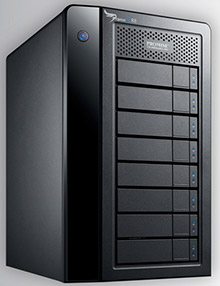 ( Please read my disclosure on product reviews here. )
( Please read my disclosure on product reviews here. )
Recently, the folks at Promise Technology sent me an 8-bay Pegasus2 Thunderbolt RAID to evaluate.
NOTE: This is due to my meeting Elaine Kwok, product marketing manager for Promise, at the recent Storage Visions 2014 conference. You can hear her audio interview here.
As I was researching and testing this unit, I realized that this article needs to be part technical review and part a discussion on our expectations on storage technology today.
EXECUTIVE SUMMARY
The Promise Pegasus2 Thunderbolt RAID is fast, easy to setup, fast, easy to use, fast, provides a ton of storage space, fast, and runs like any other Macintosh hard disk. Oh, and did I mention that it is fast? It is.
It provides massive storage, excellent speeds, all at a reasonable price. It isn’t as fast as an all-SSD unit, but it costs far less and holds far more.
WHAT I WAS SENT
Promise sent me their latest Pegasus2 8-bay RAID, containing eight 3 TB drives configured as a RAID 5. It formatted to 21 TB of usable space. All the drives were installed prior to shipping. It has a retail price of around $3,500, including all drives.
NOTE: Here’s an article that describes what RAID 5 means.
In the box are seven Quick Start Guides in fourteen languages. New users should quickly skim this because of an important note on synchronization. Connecting the drive is trivial: Plug in two cables – power and Thunderbolt – turn on your computer and the Pegasus, and get to work.
The Pegasus arrived formatted, but not synced. What syncing does is build the parity data between all the drives so that if a drive dies, you don’t lose all your data. While the drive is useable immediately out of the box, you don’t get access to its full performance until syncing is complete. For a drive this size, syncing took 10 hours, 42 minutes and 33 seconds. (Um, why, yes, I did time it.)
IMPORTANT NOTE: Before doing any work requiring maximum performance, wait until syncing is complete. The best advice is to plug the unit in and let it do its thing overnight. In the morning both you and it will be ready to work.
I ran these tests based upon the factory default settings. You can improve performance a bit more by turning on “Forced Read Ahead,” which is disabled by default. However, this requires working with Terminal and the Unix command line interface. Promise can provide instructions.
This unit comes configured as a RAID 5. You can also configure it using Disk Utility as a RAID 0. This will be faster than RAID 5, and store more, but in the event one drive dies, you lose all your data. I happily use smaller RAID 0’s in my editing. But for something this big, I want the security of knowing my data is safe in the event of a drive crash.
WHAT MAKES THIS SPECIAL
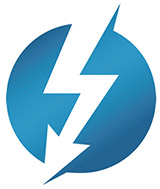 The Pegasus2 is the first RAID that supports Thunderbolt 2, the new communications protocol that was released with the new Mac Pro. This new protocol supports data transfer rates up to 2.2 GB/second.
The Pegasus2 is the first RAID that supports Thunderbolt 2, the new communications protocol that was released with the new Mac Pro. This new protocol supports data transfer rates up to 2.2 GB/second.
NOTE: That preceding paragraph is a completely true statement, but it leads to some wildly incorrect conclusions. I’ll explain further in the next section.
Thunderbolt 2 is fully compatible with Thunderbolt 1 devices. As you’ll see below, the Pegasus works perfectly – though not at the same speeds – with both iMacs and Mac Pros, and operating systems 10.8.5 and 10.9.1. In other words, you can use this unit on any Mac with a Thunderbolt connection.
THE PROMISE RAID UTILITY
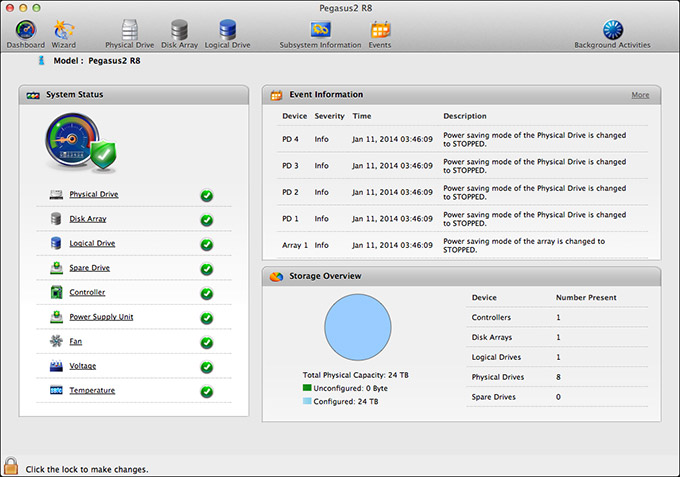
Shipped on the Pegasus RAID is a utility that allows you to configure and monitor your RAID. I found this utility cleanly designed, simple to navigate and with access to the controls that I needed to configure and monitor the unit.
My only wish for this was that it would allow us to turn on Forced Read Ahead and avoid a trip to the Terminal.
THE THUNDERBOLT TRAP
Thunderbolt 1 supports data transfer speeds (also called “bandwidth,” or “data transfer rate”) of up to 1.1 GB/second. Thunderbolt 2 supports data transfer speeds of up to 2.2 GB/second. EXCEPT… that is the speed of the connection between the two devices. Actual device speeds are less, sometimes FAR less, than the protocol will support.
In the “olde days” of USB 2 and FireWire, both of which are communications protocols between hard disks and computers, the protocol was slower than the hard disk. So the protocol determined how fast your storage could transfer data.
Now, with Thunderbolt, the protocol is FAR faster than a hard disk. This means that the speed of your storage is determined by the speed of the hard disk, NOT the protocol.
Here’s the secret formula: For every hard disk in your storage device, the data transfer rate is about 120 MB/second. There is some variation between drives, but this number is a good place to start.
Solid State Drives (SSD) will transfer data faster that spinning hard disks, but even an SSD drive is slower than the protocol itself.
NOTE: The Pegasus2 only uses spinning hard disks, driven by a hardware RAID controller, without any SSD acceleration. Hardware RAID controllers are MUCH faster than software RAID controllers. (Drobo, for example, uses a software RAID controller.)
Here are some speed examples:
In other words, the Thunderbolt protocol is screaming fast. But the speed of your storage is determined by the number of drives contained in it.
NOTE: For comparison of how much speed you need, a single ProRes 422 clip in HD requires about 18 MB/second for playback. AVCHD files require about 3 MB/second. So if you are doing single-camera editing, ANY Thunderbolt device will be fast enough for editing. The challenge comes in editing multicam footage, or higher resolutions than 1080p HD.
The advantage to the Pegasus2 supporting Thunderbolt 2 is that, while the RAID won’t take advantage of the speed of this protocol, any Thunderbolt 2 devices (think monitors) that are connected into the Pegasus will get the full benefit of the Thunderbolt 2 protocol.
MAC PRO PERFORMANCE TESTING
I decided to do four types of performance testing:
All speeds were measured using the Blackmagic Design Disk Speed Test utility.
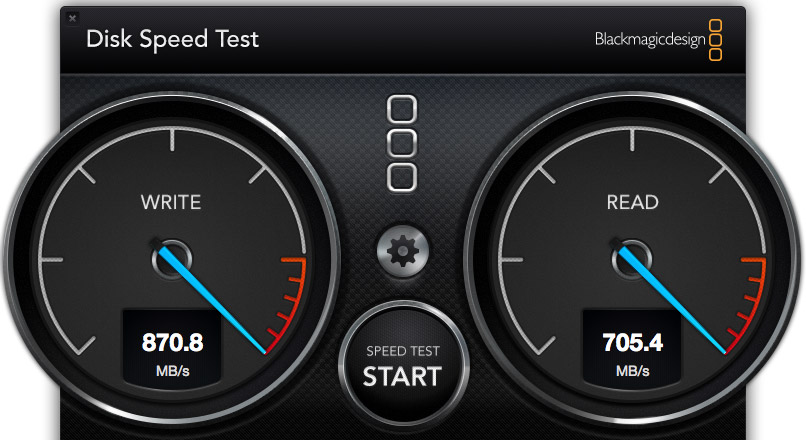
The Pegasus2, when directly attached to the Mac Pro, generated these results. Write speed shows how fast the unit records information (think importing, rendering and exporting), while the Read speed shows how fast it plays back information (think editing).
These speeds are the fastest of any RAID I’ve measured to date.
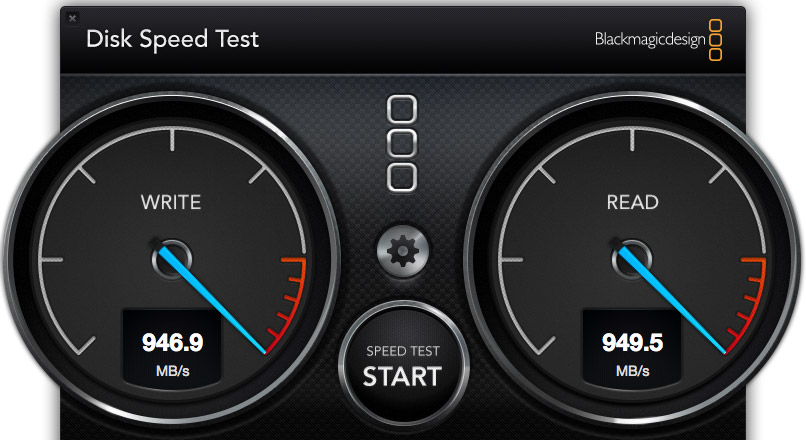
However, compare the speed of the Pegasus to the internal SSD drive of the Mac Pro. WOW! Much faster. Obviously, we should only use the internal Mac Pro drive for all of our editing.
Wrong. Really, really wrong!
First, the internal Mac Pro drive only holds 256 GB of data. Just one season of my 2 Reel Guys web series has more than 2 TB of data, which far exceeds the size of any SSD drive affordable by mere mortals. Or, more recently, my FCP X training created 8 TB of master video files! SSDs can’t handle media files of this size.
Second, as I discovered later in my testing, performance drops when background processes run, in fact, it often fell 30 – 50%. This means that we can’t count on consistent performance from the internal drive, because it is serving the needs of the operating system, all active applications, and all background processes. What may be fast enough one second is too slow a second later because some process is now running in the background.
Third, it is easy to add more external storage. Expanding the internal SSD is not simple.
Fourth, it is easy to move external storage from one computer to the next by simply unplugging the cable.
The internal drive is useful and has some advantages for certain specialized edits, but external media storage is essential for any except the smallest projects.
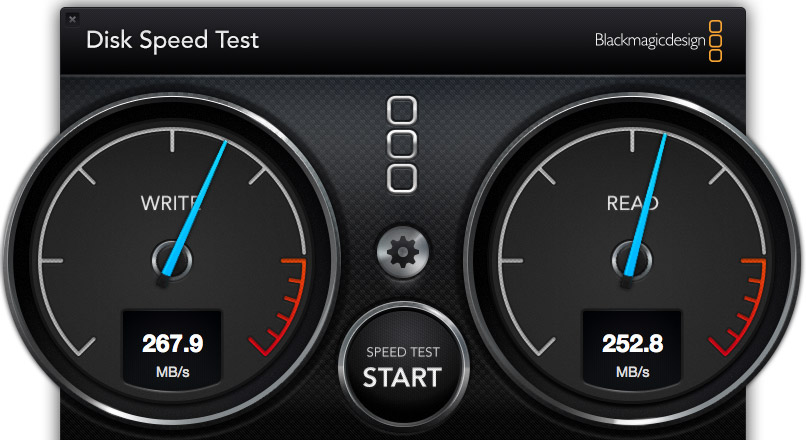
I also wanted to test whether there was any loss in speed when connecting a second RAID to the Promise. These are the results when connecting a G-Technology 2-drive RAID 0 directly to the Mac Pro.
NOTE: The G-Tech, too, is a Thunderbolt device, but its speeds are less because it only contains two drives. Hence my earlier discussion about the protocol not determining the speed of your storage.
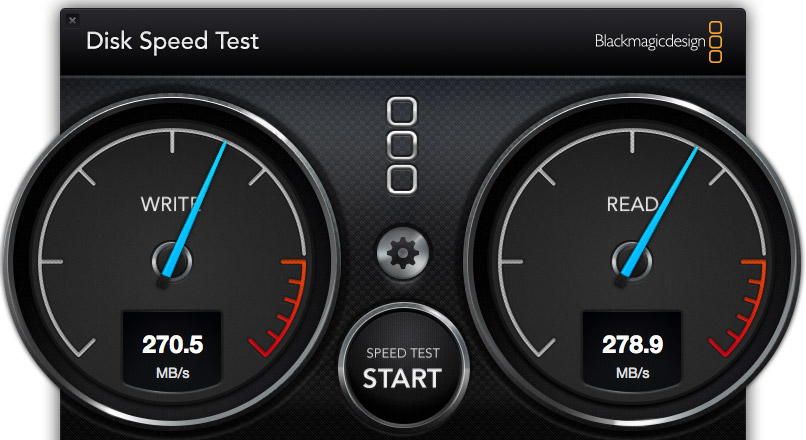
These are the results when connecting the G-Tech RAID as part of a three-drive chain. The RAID was at the end of the chain. It was faster, in fact. So there does not appear to be any significant speed loss when daisy-chaining devices. Essentially, the G-Tech transferred data at the same speed, regardless of whether it was attached directly to the Mac Pro, or as part of a storage chain.
NOTE: Another weird fact is that test results vary. Hard disk speed is a factor of how empty it is – empty is faster, how big the files are – bigger files transfer faster, and the size of the data blocks being transferred at one time – bigger blocks transfer faster.
iMAC PERFORMANCE TESTING
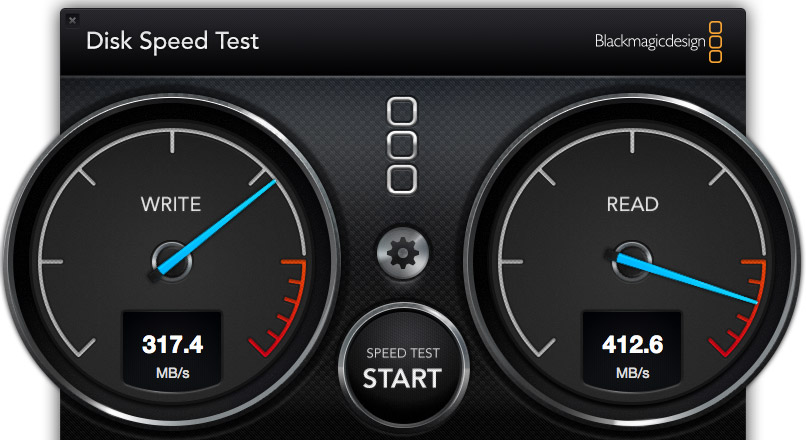
Here’s the speed of the iMac’s internal Fusion drive, running under Mac OS X 10.8.5, in a dual-boot configuration. Notice that it is about 1/3 the speed of the Mac Pro, even though the iMac is accelerated with an internal SSD drive.
NOTE: It was when running this test that I saw the 35% drop in performance when a background process started running.
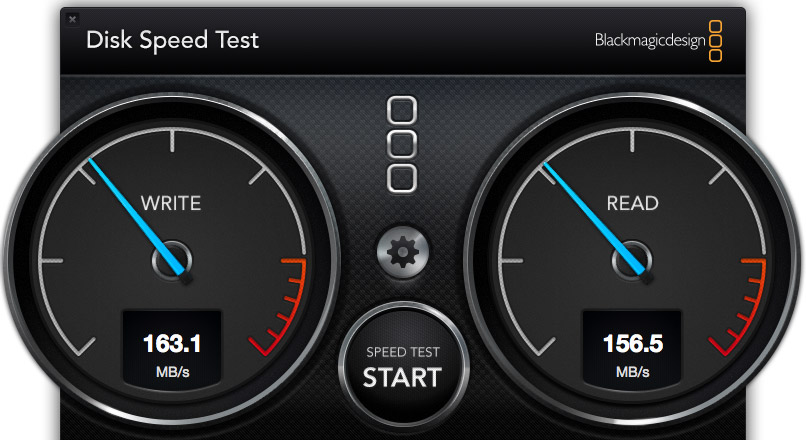
To further complicate matters, this speed test shows the same iMac, running under Mac OS X 10.9.1, and accessing its internal drive. The speeds are 50% slower than when running 10.8.5. This is probably because the dual boot drive doesn’t have enough free space. Using the internal drives is easy, but is no guarantee that we will get consistent performance.
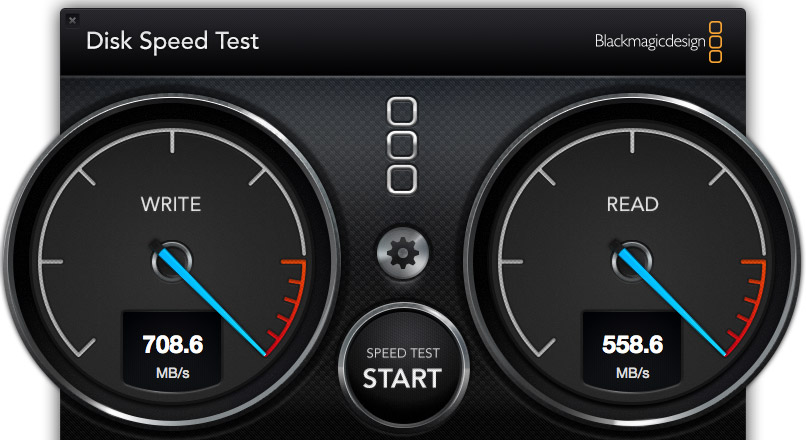
Here’s the speed of the Pegasus direct connected to the iMac running 10.8.5. Not as fast as when connected to the Mac Pro, but still pretty darn quick.
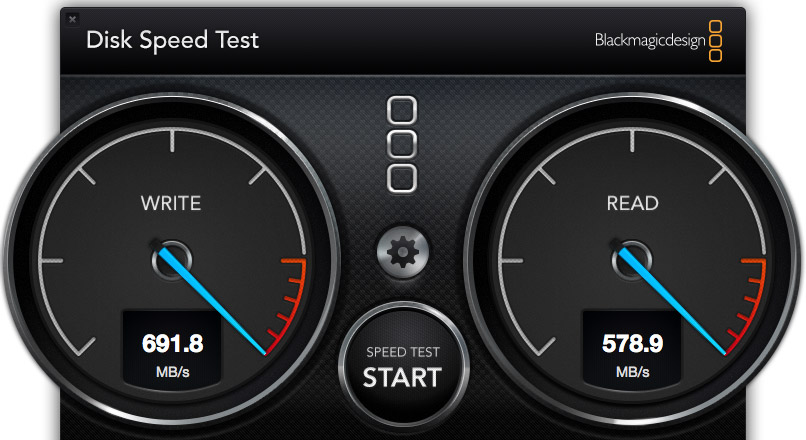
Here’s the speed of the Pegasus direct connected to the iMac, running 10.9.1. Essentially, while the speed of the Pegasus is not as fast as the Mac Pro, the speeds are pretty much the same for both 10.8.x and 10.9.x.
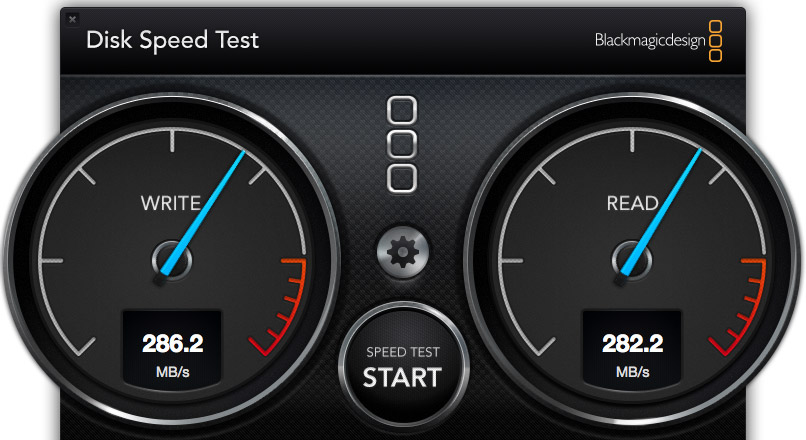
Here’s the speed of the G-Tech when connected to the iMac. In this case, it is about 10% faster on the iMac than on the Mac Pro. (The speeds were the same regardless of operating system, and regardless of whether the unit was directly connected or looped through the Pegasus.)
REAL-WORLD TESTS
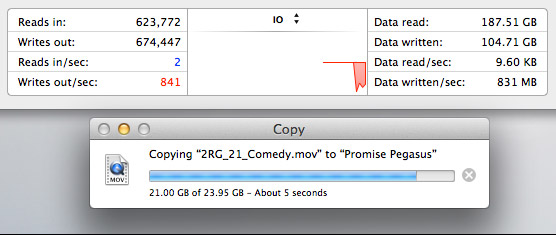
The Pegasus copied a 23 GB file from the Mac Pro’s internal drive to the Pegasus at more than 800 MB/second. I ALWAYS want file transfers to go faster, but these are excellent numbers.
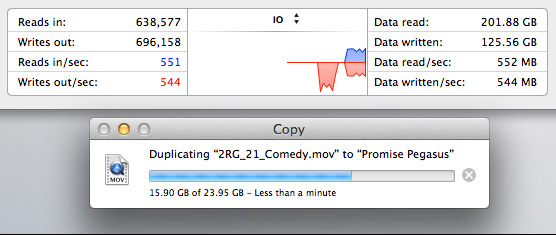
The Pegasus duplicated a 23 GB file stored on the Pegasus back onto the Pegasus at about 550 MB/second. This is slower because the file needs to be read from the RAID, then written back to the RAID all at the same time.
MULTICAM EDITING
Multicam editing taxes your computer and storage systems more than any other form of editing.

So, to test this, I created 12 versions of a 12 minute 2 Reel Guys episode.
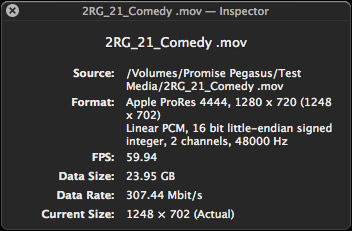
Each movie was 23 GB in size, using the ProRes 4444 codec with a 720p image size and 59.94 frame rate. (ProRes 4444 is both the highest quality and largest file size of all the ProRes codecs.)
Upon importing into Final Cut Pro X v10.1, the software immediately started creating audio waveforms and transcoding the media into proxy files (at my request). Just as a test, I tried doing multicam editing while those background processes were running. Didn’t work, I got dropped frames immediately. It took the system about fifteen minutes to finish all its prep work.
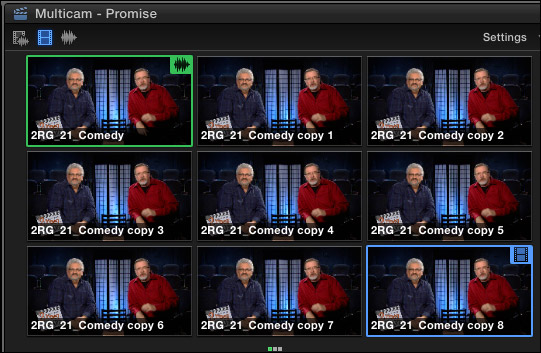
Once the background processing was done, FCP X could play and edit a nine-camera multicam clip with image quality set to Better Quality with no dropped frames. Wow. Just, wow…
NOTE: I did get dropped frames when trying to play 12 clips, however.

As you can see, playing all nine streams did not tax the storage system….

… or the CPUs.
However, my STRONG recommendation for multicam editing is to edit using proxy files. For example, the Mac Pro edited all twelve proxy streams without breaking a sweat. Based on what I saw, I would expect the Mac Pro, combined with a Pegasus RAID to easily, easily edit 24 streams of multicam video with horsepower to spare.
MISC. OPERATIONAL NOTES
The Pegasus follows the computer in terms of sleep. If the computer goes to sleep, so does Pegasus. It can take up to 20 seconds for it to wake back up after going to sleep. It the computer doesn’t go to sleep, the Pegasus stays awake, too.
The Pegasus took longer to mount to the desktop than the G-Technology drives. G-Tech was ready in about five seconds. The Pegasus was ready in about 15.
The RAID management tool shipped with the Pegasus is very nicely done.
CONCLUSIONS
 The Pegasus2 is a very fast RAID, easy to setup and as easy to use as any other Macintosh hard disk.
The Pegasus2 is a very fast RAID, easy to setup and as easy to use as any other Macintosh hard disk.
It runs on any Mac that has a Thunderbolt connection, with the added advantage of supporting the new Thunderbolt 2 protocol. It runs the fastest on a Mac Pro, but, for most editing projects, the Promise has speed to burn for any editing project on any Mac.
Apple has long supported these devices for any intensive media application, and, now, after working with one myself, I can agree.
The Promise Pegasus2 Thunderbolt RAID is an amazing tool at a very reasonable price.
Learn more at www.promise.com.
2,000 Video Training Titles
Edit smarter with Larry Jordan. Available in our store.
Access over 2,000 on-demand video editing courses. Become a member of our Video Training Library today!
Subscribe to Larry's FREE weekly newsletter and
save 10%
on your first purchase.
142 Responses to Product Review: Promise Pegasus2 RAID
Newer Comments →-
 Bob Cole says:
Bob Cole says:
January 13, 2014 at 7:16 am
-
 Victor says:
Victor says:
January 13, 2014 at 11:28 am
-
 Victor says:
Victor says:
January 13, 2014 at 11:30 am
-
 Blair Thornton says:
Blair Thornton says:
January 13, 2014 at 7:21 am
-
 Larry says:
Larry says:
January 13, 2014 at 9:48 am
-
 Blair Thornton says:
Blair Thornton says:
January 13, 2014 at 9:52 am
-
 Blair Thornton says:
Blair Thornton says:
January 13, 2014 at 10:23 am
-
 Larry Jordan says:
Larry Jordan says:
January 13, 2014 at 10:50 am
-
 Blair Thornton says:
Blair Thornton says:
January 13, 2014 at 11:03 am
-
 Victor says:
Victor says:
January 13, 2014 at 11:31 am
-
 Blair Thornton says:
Blair Thornton says:
January 13, 2014 at 11:49 am
-
 Victor says:
Victor says:
January 13, 2014 at 4:05 pm
-
 Al B. says:
Al B. says:
January 13, 2014 at 12:00 pm
-
 Larry Jordan says:
Larry Jordan says:
January 13, 2014 at 12:07 pm
-
 Al B. says:
Al B. says:
January 13, 2014 at 12:08 pm
-
 Larry Jordan says:
Larry Jordan says:
January 13, 2014 at 12:13 pm
-
 HaR says:
HaR says:
January 13, 2014 at 3:09 pm
-
 Larry Jordan says:
Larry Jordan says:
January 13, 2014 at 3:23 pm
-
 HaR says:
HaR says:
January 13, 2014 at 4:04 pm
-
 Larry Jordan says:
Larry Jordan says:
January 13, 2014 at 4:13 pm
-
 Jon Roemer says:
Jon Roemer says:
January 15, 2014 at 9:05 pm
-
 Victor says:
Victor says:
January 15, 2014 at 9:31 pm
-
 Kw says:
Kw says:
January 17, 2014 at 11:59 pm
-
 Larry Jordan says:
Larry Jordan says:
January 18, 2014 at 12:26 am
-
 Michiel says:
Michiel says:
February 21, 2014 at 8:24 am
-
 Agustín says:
Agustín says:
March 14, 2014 at 5:21 pm
-
 Jeffry Morgan says:
Jeffry Morgan says:
March 15, 2014 at 12:47 pm
-
 Al B. says:
Al B. says:
January 18, 2014 at 12:34 am
-
 Larry Jordan says:
Larry Jordan says:
January 18, 2014 at 12:42 am
-
 Al B. says:
Al B. says:
January 18, 2014 at 12:58 am
-
 Clive DSouza says:
Clive DSouza says:
October 8, 2014 at 3:21 pm
-
 Victor Pacheco says:
Victor Pacheco says:
January 18, 2014 at 8:55 am
Newer Comments →What about RAID 6? With all that storage space available, the added reliability would be well worth the hit to capacity.
Hi Bob,
Pegasus fully supports RAID 6 although RAID 5 is default.
Read performance is about the same. Writes have a bit more overhead due to the additional
XOR parity calculation. Also except to loose an additional drive worth of capacity compared to RAID 5.
To see the drives that ship with Pegasus 2. see here:
http://www.promise.com/media_bank/Download%20Bank/Compatibility/Pegasus2_Compatibility%20List%20v1.1-201301216.pdf
Great article Larry, but I’m interested to know what hard drives Promise ships in this unit. Like you, I use a 2 disk Raid0 Thunderbolt drive for my work, but I use a Lacie Little Big Disk 6Tb Thunderbolt instead of your G-Drive. The Little Big Disk uses two Seagate Barracuda drives and that gives 330Mb/sec performance. (See my results here: http://www.girafxmedia.com/images/LaCieLittleBigDisk.jpg) If the Seagate Barracuda’s perform that much better than the Hitachi drives in the G-Drive, it would be interesting to see this Promise Raid with 8 Seagate drives. One could expect a performance of say 165Mb/sec x 7 = 1,155 Mb/sec. a 63% improvement over the stock Promise Pegasus2 RAID. That would be an interesting test wouldn’t it now?
Blair:
My understanding is that you can buy an empty unit from Promise and install your own drives. I would check on their website.
Your performance numbers are intriguing.
Larry
Apple’s website only lists the PROMISE Pegasus2 R4 (http://store.apple.com/us/product/HE150VC/A/promise-pegasus2-r4-diskless-4bay-thunderbolt-2-raid-system?fnode=5f) as a diskless option. If you know how to order the PROMISE Pegasus2 R8 diskless I’d like to know.
Promise Sales just confirmed “Only the R4 is available diskless, and only from the Apple online store” – Brian Reynolds Inside Sales
Blair:
One reason for this, is that if you already own a Pegasus 1, you can buy the empty Pegasus 2 and move the drives across to take advantage of the new interface.
I would be surprised, however, if, when you moved the drives to the new unit if there was any increase in speed.
Larry
Promise’s Pegasus2 Compatibility list with drive models show they support the Seagate ST4000DM000 4Tb drive in Pegasus2 . PROMISE also says “We have seen speeds of 1350MB/Sec with the R8 in Raid 5”, so perhaps the 32Gb R8 ships with Seagate drives and has better performance.
Thanks.. here is the HCL:
http://www.promise.com/media_bank/Download%20Bank/Compatibility/Pegasus2_Compatibility%20List%20v1.1-201301216.pdf
Victor, The HCL indicates the Seagate ST4000DM000 (the Barracuda replacement) as the only 4Tb drive you use. Can you confirm then that the 32Gb Pegasus2 R8 ships with this drive and obtains speeds of 1350MB/Sec in Raid 5?
Blair,
That is correct. The max bandwidth you will see out of the Pegasus (32 or 24TB SKU) using our home grown bench tool that mimics Final Cut is 1350MB/s (read and write). See the following KB:
http://kb.promise.com/KnowledgebaseArticle10394.aspx
Hope to very soon release the Promise bench tool that is more aligned with the “real world” applications like Premiere and Final Cut. AJA and BM bench tools are great tools but like all bench-tools not all are an exact representation of the real world.
Interesting. I just ran the BM tests on my iMac 2012 16GBs RAM 10.9.1 connecting my almost empty 2TB RAID 5 OWC box, through a LaCie eSata to TB hub. My speeds were 193 and 251 (if the BM are an accurate measure). Going to 1GB testing upped my write speeds to 210 and 251. My speeds for a GTech esata drive (through the LaCie hub) with a single 7200 drive in it were 108 and 88. USB 3 RAID 1 OWC w/dual 1TB 7200 RPM drives came in at 155 and 147.
So it would appear without deeper testing, that you will not get even close to the same throughput going from esata through a TB converter as you saw Larry on a native TB RAID array. Since I can’t test the eSata directly anymore, as my older MacPro is gone, folks might want to run this test before upgrading to a newer machine. It’s an interesting problem, whether it’s worth it to upgrade my OWC eSata to a TB drive…
So it means moving all project work video to the RAID 5 machine and storing everything on any of the other drives. Ok. That’s good to know, though I suspected it all along.
What might I be missing in this test? Is the product (BM speed test) as trustworthy as it appears?
By the way, I tried this both with my normal array of background processes running (Adobe Cloud, Intego Anti-virus, Chrome, etc.) running and then with them turned off. No real difference. No reason to shut down background processes on my machine while editing.
Al:
I consider the Blackmagic tester highly trust-worthy. Another good one is the AJA Speed Test – also free, from AJA.
Keep in mind that measuring disk speed is somewhat variable. So results that are ±20 MB/second at these speeds are, essentially, the same.
Whenever you convert from one protocol to another, speed is lost — as you saw in your tests. Still, for single clip editing (meaning not multicam) your speeds are perfectly OK. You don’t need to rush out and buy all new gear immediately.
I also agree that there is no reason to shut down background processing – especially because you are storing media on external drives. Background processing only becomes a factor when you are storing media on the internal boot drive.
Larry
A word of caution on buying diskless RAID enclosures. The RAID controller is very important in the building of the RAID array, I believe. When I tried to do that, on a RAID 1 drive from OWC, moving it to *another same OWC RAID array that had a built in controller* it killed the RAID and broke the drive into two identical drives with no ability to get the RAID restored. If you do that on a RAID 5 unit you might never get the data back, because of the striping. I could not *recreate the RAID 1 once it was broken!* My understanding from researching that, is that if you buy an empty RAID array, you will still have to *backup all your data off the current RAID* and reformat the drives in the new RAID. Luckily, I had backed up all the data, because I was worried about that very issue, and unfortunately was proven right. Just sayin’.
Al:
An EXCELLENT caution, thanks.
However, as I was writing this article I was told by the folks at Promise that moving disk arrays was possible. I’ll send a new note to Promise to double-check my facts.
– – –
UPDATE
I’ve just been told that Pegasus 1 drives will work in a Pegasus 2 as long as you move all the drives as a set and keep them in the same order, from top to bottom, as they were in the Pegasus 1.
Larry
It would be very interesting to see, if the RAID performance drops durind video playback when a thunderbolt videocard is used (eg aja or blackmagic). Or were the FCPX Multicam tests already conducted with a thunderbolt videocard connected?? I am worried, the PCI bridge behind the thunderbolt controller could be quite a bottleneck …
HaR:
I tested this on a new Mac Pro, which includes Thunderbolt ports. I don’t have a way of testing this using a Thunderbolt bridge card.
Larry
Thank you for your fast response, Larry. I meant the PCI bridge INSIDE the MacPro 2013 to which the 6 thunderbolt ports (and 3 thunderbolt controllers) are connected. I am no computer expert. But I do know there is still tons of electronics that separate those 6 superfast thunderbolt ports from the superfast CPU that needs to process all data. And under certain circumstances those electronic circuits will turn into bottle necks and data lanes will jam. I was wondering, if the Pegasus RAID is still able to sustain 9 streams of ProRes 4444 720p59.94 on the MacPro 2013 if you connect a thunderbolt I/O solution to display video, since this will be a very common scenario. This could be either the AJA Io XT (or the announced Io 4K) or the Blackmagic Ultrastudio series.
There is one Thunderbolt controller for every two ports, and Apple is using the latest version of PCI3 bus architecture AND bragging about this will support up to 3 4K monitors as well as an external RAID.
I suspect this isn’t an issue – worst case, we would plug the RAID into one set of two ports and the monitor into a separate set (up or down).
However, I don’t have the ability to test this to be sure.
Larry
Larry – How does this compare to the Areca 8050? I assume it’s a bit easier to set up. What about size and noise?
It also looks like thunderbolt 2 gets you a bit faster speed on a new Mac Pro but not a huge difference.
Hi Jon..
i’ll let Larry reply on the unreleased Areca 8 bay.. From Promise Pegasus R8 you can expect:
What is the real throughput of Pegasus2 R8?
Using Promise home grown bench test tools:
For RAID 0 ForcedReadAhead enabled:
-1340MB/s sequential writes
-1350MB/s sequential reads
For RAID 5 ForcedReadAhead enabled:
-1020MB/s sequential writes
-1030MB/s sequential reads
What parameters does Promise use in their testing to gauge the above performance?
100% sequential write, IO request size 1MB, Queue depth 8, file size 100GB
100% sequential read, IO request size 1MB, Queue depth 8, file size 100GB
What about the noise level of Pegasus R8?
Super quiet.. Just like the new Mac Pro..
Test Condition:
Bandwidth: 100Hz~20K Hz Environmental correction K2A=-0.1Db Measurement duration: 30 sec
Product operating noise is measured by acoustic noise tester. The acoustic noise test condition refers to ISO 7779(SPL)
Results:
Idle mode: Smaller than 27 dB
OP mode: Smaller than 32 dB
I just purchased the Pegasus2 R4 (diskless) and installed 4 Seagate ST3000DM001 3TB drives into it and the drive will NOT mount. I’ve swapped cables, tried both ports, moved the drives around inside and nothing. The unit powers on and all lights are blue, but nothing is displaying. I’m on a Macbook Air 10.7.5 OS. Any ideas why I can’t get this thing to mount? I’ve seen the drive compatibility list, but this drive is supposedly on there. Thanks in advance for any tips to get this to work…frustrated!
Kw:
I appreciate your frustration, but I don’t have an immediate answer. However, I know Promise is monitoring this review – at least for a while – so I’ll wait to see if they have an answer.
If not, contact Promise support directly – that is always a good first step.
Larry
Hi all !
I have purchased the Peagsus 2 R6 12TB. A 2000 euro box. Same problem here, it does not mount at all. PRAM reset, SMC reset, cable swap, restart, etc, etc.
Disk Utility told me it was mounted but it could not unmount while it did not appear in the finder and the link from Disk Utility (show in finder) was dead.
Here is the remedy i found after two days research that ‘worked’. It mounts now on the desktop but i’ll return it anyhow. I am not waiting for a crisis like this in the middle of a project !
-Go into Promise Utility and click on Subsystem Information.
-Click on ‘Shutdown’ and follow the instructions on screen.
-Turn the Promise on again with the I/O button on the front.
-Open Disc Utility and erase the Pegasus like you would any other drive.
POOF ! There it is… finally !
This means in my opinion that the subsystem is unreliable and is able to crash and cause this mount-unmount dispute between the Finder and the Pegasus which makes it, for me at least, an unreliable system.
I am not sure what to try next. Probably a LaCie 5Big. No RAID-5 but none of their drives has ever let me down since… my memory goes back in the digital age.
Cheers,
Michiel
Hi everyone! I’m about to buy between two options, and I’m all ears to know what do you think of it!!!
1- Pegasus R4 Thunderbolt 2 with 4 Seagate Barracuda 3TB or…
2- LaCie 10TB 5big Thunderbolt.
Which option do you think is better? I’m a video editor, HD 1080p maximum. I hope someday I can edit 4K, but most of my clients work with 720p and 1080p.
Thanks for your answers!!!
Bye!!!!
Dear KW
On the 4 Disk Pegasus 2 R4 The Max size of the Drives can only Be 2 TB X 4 any larger it wont Work. If you want more Storage space you need to Daisy Chane them together
The only clue I have is your OS is old. I wonder if 10.7.5 is on the supported OS list? This unit is TB2, right? Good luck!
Al:
i can’t speak for the OS, but Thunderbolt 2 is fully backwards compatible with Thunderbolt 1. I know, because I was easily running this RAID on my iMac which was OS 10.8.5 and Thunderbolt 1.
Larry
Right. I was wondering more about whether the 10.7.5 supported any TB. There are more clues. Googling TB and that version of the OS shows lots of issues, mainly around displays. It’s where I’d assume the problem may lie.
Enough for one night…Watson should be by soon.
Sherlock Holmes…
Victor Been trying to contact with you. Send me an email.
10.7.5 has support for thunderbolt 1 (Pegasus 1) how ever
At least for Promise Pegasus 2 it requires 10.8.5 on up.